#Aquatic Mammals
Text
A clip of a family of sperm whales happily sleeping together. Sperm whales sleep vertically in the ocean. 🐋 🎥
#sperm whales#pelagic mammals#marine mammals#aquatic mammals#whales#ocean#cachalot#Physeter macrocephalus
219 notes
·
View notes
Text


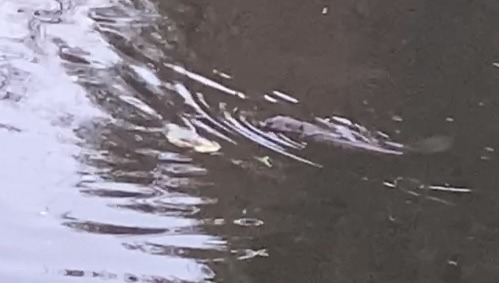
#nature video#otters#eurasian otter#lutra lutra#wildlife#aquatic mammals#fyris river#uppsala kungsängs naturreservat#uppsala#sweden#video
6 notes
·
View notes
Text
Here's the otter! The stream is right in front in the darkness so he must've jumped out and went running by.
2 notes
·
View notes
Text

I need you all to understand how good aquatic mammals are
2 notes
·
View notes
Photo

931 notes
·
View notes
Text

Elephant seals, formerly known as sea elephants.
Creatures of the sea. 1909.
Internet Archive
234 notes
·
View notes
Text
what’s the most insane thing too many of your faves have in common?
140 notes
·
View notes
Text
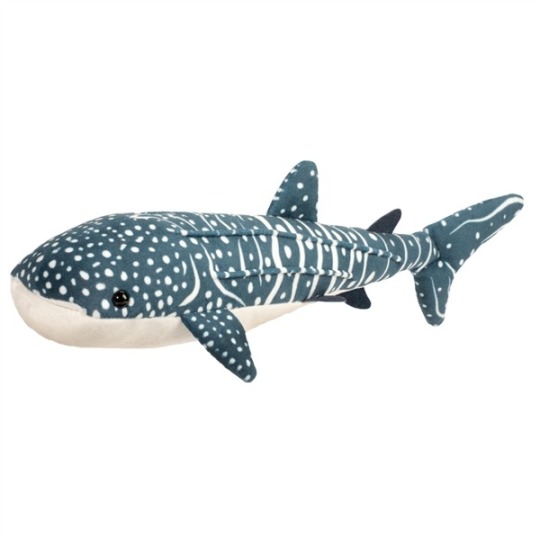
Decker the Whale Shark plushie made by Douglas !!
#plushies#plushie#plush#plush toy#plushblr#plush core#stuffies#stuffed aminals#stuffed animals#marine animals#marine mammals#aquatic life#whale#whales#whale shark#whale sharks
222 notes
·
View notes
Text
Well everyone, I performed my first ever cetacean ultrasound today!
My “patient” is in excellent health, and this session was meant merely as practice both for me and for her—ensuring she remains comfortable holding still for scans. Because whales and dolphins are too big for manual palpation or x-rays, ultrasound is how veterinarians visualize their internal organs and ensure they remain healthy. Cetaceans in human care routinely receive ultrasound scans to monitor their health, even if they are not ill or pregnant.
And it’s a great example of cooperative care! Unlike dogs and cats, which have to be sedated or manually restrained by humans in order to get diagnostic ultrasound images, cetaceans in human care are trained to float in place while the veterinarian places the ultrasound probe on them. They are free to leave the session at any time. And there’s no need for ultrasound gel, because the water acts in its place!
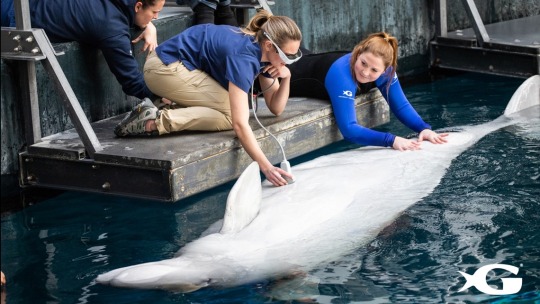
(Photo not of me… published by Georgia Aquarium when their beluga Whisper was pregnant with her calf Shila)
All in all, a great end to my externship!
#very sad to leave… but I’m heading directly to my next externship tomorrow!#another aza facility with cetaceans#my third and final externship will actually be right after I graduate because I couldn’t fit it into my clinical year#whales#dolphins#belugas#orcas#cetaceans#marine mammals#animal training#animal husbandry#vet med#zoo med#aquatic med#vet school#vet student#externships
92 notes
·
View notes
Text



The sight of chubby baby cheeks is often enough to transform even the most committed curmudgeon into a babbling softie.
Sentences become shorter, sounds are exaggerated, and the overall pattern of speech is more singsong and musical.
Researchers have dubbed this “motherese,” or, more formally, “infant-directed speech.”
“We’re not changing the words that we’re saying, we’re changing the way that we’re saying them,” says Laela Sayigh, a marine biologist at the Woods Hole Oceanographic Institution and Hampshire College in Massachusetts.
Only a handful of other species have been shown to change their calls when addressing young, including zebra finches, rhesus macaques, and squirrel monkeys.
Now, Sayigh’s new study, based on three decades of data in Florida, reveals common bottlenose dolphins use motherese — one of the first times it’s been documented in a species other than humans.
It's a major discovery, agrees Rindy Anderson, a behavioral ecologist at Florida Atlantic University who was not involved with the research.
The study, published today in the Proceedings of the National Academy of Sciences, "suggests that using these modifications when communicating with young assists them in learning how to produce these calls themselves,” she says.
Talk to me
Learning language is hard. Yet infants, incredibly, sop up the verbal soup around them and learn how to construct sentences with the appropriate structure.
How? The answer has to do with how we intuitively talk to babies.
Making our sentences shorter strips away unnecessary words. Emphasizing sounds makes words clearer. And — importantly — we increase the pitch of our speech.
Studies have shown these vocal characteristics grab and hold the attention of children far better than normal adult-directed speech.
And when parents are coached on how to use motherese, their child babbles more and has a bigger vocabulary as a toddler.
Language scientists make an important distinction between motherese and what is commonly referred to as baby talk.
The latter, they say, consists of largely made-up words with inconsistent and incorrect grammar and syntax:
It’s the difference between telling a baby, “Look at that DOGGY!” and “Wook at dat widdle puppy-wuppy!”
That’s why the list of species that use the more accurate motherese has so far been limited.
“Vocal learning is actually very rare. Out of the millions of species that use sound to communicate, there’s just a few groups that must learn their vocal communication systems,” Anderson says.
Signature sounds

When Sayigh began working with a pod of wild bottlenose dolphins in Florida’s Sarasota Bay in the late 1980s, she observed that these marine mammals shared many characteristics with humans.
For instance, mothers and their offspring live within intricate social groups held together by a complex language of songs and whistles.
Over time, the biologist began to wonder whether females use motherese to communicate with their calves.
Bottlenose mothers nurse their young for two years, and the animals generally stay with her until they’re between three to six years old, learning how to hunt, navigate, and stay safe in the ocean.
Father dolphins generally aren’t involved in rearing their young.
Dolphin communication is profoundly different from how humans talk.
The most common dolphin vocalization is their signature whistle, a sound unique to each dolphin that serves as the cetacean equivalent of a “Hello, My Name is…” sticker.
Dolphins, however, don’t use another animal’s signature whistle to direct communication.
Instead, they repeat their own signature whistle and listen for another dolphin to respond with their own.
It’s analogous to your mother standing on your front porch and yelling her own name to summon her kids, says Kelly Jaakkola, a cognitive psychologist and marine mammal biologist at the nonprofit Dolphin Research Center in Grassy Key, Florida.
As part of their ongoing research, the Sarasota Dolphin Research Program performs regular veterinary exams on the wild dolphins, which have gotten used to the scientists’ presence.
During these exams, Sayigh and colleagues would sometimes attach a small recording device called a hydrophone to a mother dolphin’s forehead with a fist-size suction cup that the researchers later removed.
By analyzing recordings of 19 different female dolphins over 34 years, Sayigh found that the signature whistles of dolphin mothers had a greater range of frequencies — the high pitches were higher and the lows were lower — when their calves were nearby.
The high-pitched sounds are out of the range of human hearing.
Endless questions
To Jaakkola, who wasn’t part of the study, this work was “a fantastic first step.”
“The data here are beautiful,” she says. “The trick comes in possible interpretations of what’s happening.”
The work only looks at dolphin communication in one specific context, which means scientists can’t say definitively that the dolphins are speaking to their calves in motherese, Jaakkola says.
For instance, the results could be due to vocal changes in caused by lactation, or some other unknown variable.
However, in a 2017 study, researchers noticed an identical change in mother dolphins’ signature whistles while examining the effects of human-made noise, which lends support to the authors’ conclusions that the dolphins change their pitch as needed.
For Sayigh, the questions are endless — and fascinating.
“I just can't even articulate what an amazing project it is. I could spend three lifetimes there,” she says.

#dolphins#infant-directed speech#motherese#bottlenose dolphins#Proceedings of the National Academy of Sciences#baby talk#Sarasota Bay#Florida#signature whistle#Dolphin Research Center#Sarasota Dolphin Research Program#hydrophone#National Geographic#Nat Geo#aquatic mammals
2 notes
·
View notes
Text

Whale giving birth
#animals#science#education#nature#photography#sea#mammal#cute animals#funny#lol#wholesome#adorable#landscape#paradise#explore#travel#photographers on tumblr#gifs#ocean#reproduction#scientific research#mating#underwater#giving birth#whale#sea creatures#aquatic
56 notes
·
View notes
Text
Wet Beast Wednesday: platypus
Since I've been designing original Pokemon for a hypothetical Australia-based region I've been doing some research on Australian fauna and one of them (which I made into a starter) is the famous platypus. Join me and we will learn why these animals are so weird I don't blame the European naturalists who thought they were hoaxes until presented with a live specimen. I mean you can blame European scientists of the time for a lot of things, but doubting the platypus isn't one of them.
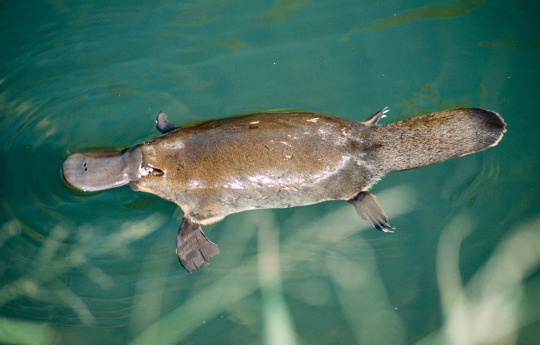
(image: a platypus at the surface of the water, seen from above. It is a brown, furry mammal. Its legs are very short, with long webbed tows. Its tail is broad, flat, and furry. It has a large duck-like bill at the front)
The first preserved Platypus specimens brought to Europe were thought to be hoaxes made by taxidermists attaching parts of different animals together, like the Fiji mermaid or jackalopes. Its pretty clear why they thought this as platypi (there's not definitive plural of platypus and platypi is the one I refer) look like real-life chimeras. A mole-like body (indeed, they were originally thought by naturalists to be species of mole) with a duck's bill, otter's feet, and beaver's tail. In fact, platypi are none of the above but are instead one of five surviving species of monotremes, the smallest and most basal lineage of extant mammals alongside the marsupials and placentals. Monotremes possess many traits distinct from other mammals and taxonomists currently believe that the monotreme lineage split off from the lineage of live-birth giving mammals prior to marsupials and placentals diverging from each other. Differences that monotremes have from all other mammals include a lower body temperature, lack of external ears, different jaw and inner ear structures, a cloaca (combination of the excretory and reproductive tracts into a single hole), more reptile-like embryo development, and the fact that they lay eggs instead of giving live birth. Many of these traits (especially the cloaca and laying eggs) are believed to be holdovers from pre-mammalian ancestors and thus monotremes are highly valued by scientists studying mammal evolution.
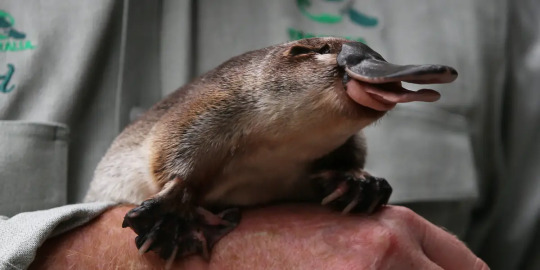
(image: a platyus standing on a person's hand. It is around the same size as the hand. It is seen from the front, with its head turned to the right. Its mouth is slightly open)
Platypi are semi-aquatic animals found in rivers and streams along eastern Australia and Tasmania. They are the only living members of their genus and family, though fossil relatives have been found. Their size varies based on habitat and ranges from 0.7 to 2.4 kg (1.6 to 5.3 lbs). Males average 50 cm (20 in) and females average 43 cm (17 in). Platypi are covered in fur that traps a layer of air to insulate them while swimming. The fur is bioflourescent, producing a blue-green glow when exposed to ultraviolet light. The tail is used to store fat and will glow larger in a well-fed individual. All four feet are webbed, the front feet more so. The style of swimming used by platypi is unlike that of any other amphibious or aquatic mammal. Other mammals use their hind feet and/or tails for propulsion. Platypi instead use their front feed for propulsion. The hind feet and tail are only used for steering. When on land, platypi curl up their front toes and walk on their knuckles to protect the webbing between their toes. The eyes are small and weak and are not used when hunting.

(image: a platypus seen from above and below, fluorescing under black light. Its top looks dark blue with splotches of purple while the underside is a lighter green-blue with purple towards the middle)
The bill is the most important organ for finding prey. All living monotremes are capable of electroreception, the detection of electric fields. These fields are produced when prey contracts its muscles and the platypus is sensitive enough to detect very small prey. The electroreceptor organs are located on the bill and run in lines from front to back. The distribution of the organs in distinct lines allows the platypus to determine the direction of the source of an electric field by sensing which line feels the field most strongly. The bill is also covered uniformly in mechanoreceptors used for touch. Platypi hunt by digging their bills through the sediment at the bottom of the water and detecting prey. This method of hunting and use of electroreception allows platypi to hunt in very murky water. Prey consists primarily of worms, insect larvae, and crustaceans. Platypi are born with teeth in their bills, but they fall out quickly and are not replaced. Some fossil species apparently retained their teeth into adulthood. The insides of the bill are lined with ceratodontes, plates covered in rough, keratinized surfaces that are used to grind up food.

(image: a platypus foraging for food at the bottom of a river. The front of its bill is poking into the sandy river bottom. There is a submerged log in the background and multiple small fish in the foreground)

(image: a scientific diagram showing three drawings of a platypus from three angles and the area it can detect electric fields. source)
As if all that wasn't strange enough, platypi are also one of the few species of venomous mammals. The male platypus has spurs on the hind feet that inject venom. This venom is powerful enough to kill dogs, but is not fatal to humans. Instead, it causes swelling and increases sensitivity to pain. This can last for weeks to months and can be agonizing. Female platypi are born with the spurs, but they never develop venom and fall off by their first birthday. Males use their spurs to fight over territory and mates.

(image: a person showing off a male platypus's spur. The platypus is mostly out of frame, but a hind leg and some fur is visible, wrapped in a sheet. A human hand is gripping the hind leg near the toes and holding it in place. The spur is curved and conical and larger than any of the actual claws. It is located near the heel)
Platypi live in simple burrows dug along the water's edge around 30 cm above the surface of the water. They are often hidden behind roots or plants. Platypi spend most of their time in the burrow sleeping for up to 14 hours a day. When not sleeping, they spend most of theer time in the water hunting. Dives last up to 30 seconds with a 10-20 second surface interval. Platypi will travel up to 7 km (4.3 miles) from their burrows to hunt. They maintain territories and will attempt to chase competitors of the same sex out. Males have larger territories than females and their territories usually overlap with those of 3 or 4 females. Platypi are nocturnal and crepuscular (active at dawn and dusk) but have been known to come out on cloudy days. They are typically active for 12 hours per day and spend most of that time hunting. A platypus eats up to 20% of its body weight daily. Platypi are preyed upon by snakes, goannas (monitor lizards), various birds of prey, and possibly crocodiles and invasive foxes.
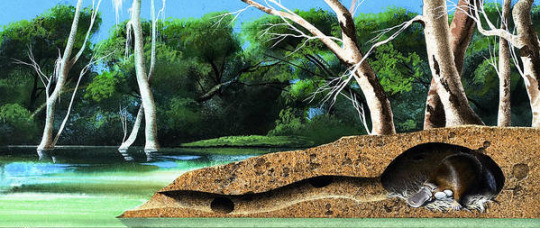
(image: a drawing of a cross-section of a platypus burrow. The burrow is located in a river bank with the opening right by the water. A long tunnel leads to a round chamber. In the chamber is a platypus with two eggs. Art by David Nockels)
Platypus mating season lasts between June and October every year. During this time, males will compete with each other for mates using their venomous spurs. Some males will maintain territories and force other males out while other males are more transitory and will go looking for mates. Females only mate with a single male every season. Strangely, females have two ovaries but only the left one is functional. After mating, the female will retreat to her burrow. While most egg-laying animals will lay they eggs as soon s they are formed, platypi retain their eggs internally for 28 days before laying them, after which they will continue to develop for 10 days before hatching. Most layings result in 2 eggs. The female curls around her eggs to incubate and protect them. Newborn platypi are called puggles and they are blind, hairless, and defenseless. As with other mammals, they feed on their mother's milk. Platypi do not have nipples and instead, the milk is secreted through the skin and into grooves on the mother's belly, where the puggles lap it up. While the puggles are developing, the mother spends less time out foraging, though she will increase the time foraging as her offspring develop. Weaning happes at 3-4 months, after which the juveniles will leave the burrow and set out on their own. Mothers have been observed laving behind soil plugs at the entrance to their burrows while there are offspring are in them. They are used to squeeze off water as the female returns to her burrow, preventing cold water from reaching the offspring.
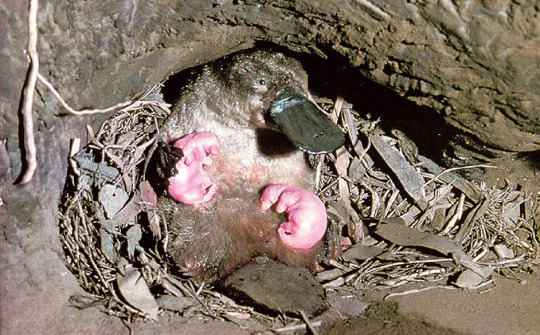
(image: a reconstruction of a mother platypus and puggles. They are in a dirt burrow lined with bits of leaves and bark. The mother is on its back and looking toward the camera. There are three puggles, which share the same body plan, but are very small and entirely pink. Tey are sitting on the mother's abdomen)
Platybi are classified as near threatened by the IUCN, though some argeu they should be reclassified as endangered. Their habitat range has decreased since European colonization of Australia and they are threatened by habitat loss, dams, pollution, and bycatch. Aboriginal Australians historically hunted them for food and Europeans also hunted them for fur, which was outlawed in 1912. The platypus was and is culturally relevant to Aboriginal peoples sharing its range, particularly the native peoples of the Murray river. There are multiple Dreamtime stories of the platypus, many dedicated to explaining how it ended up the way it is. In one, originating from the upper Darling river, a female duck named Daroo or was either seduced or kidnapped by a male water rat named Biggoon or Bilargun. After escaping, she laid two eggs that hatched into the first platypi, inheriting their mother's bill and webbed feet and father's body and fur. Another story from the same region says that the land animals, water animals, and birds all wanted the platypus to join their group and tried to convince it to join. The platypus decided that it didn't need to join any of the groups to be special, but still wanted to be friends with all of them and so took on traits from all groups.

(image: the Ironbarks Platypus, an Aboriginal Australian rock carving of a figure typically interpreted as a platypus. It is very simple, with a roughly rectangular shape with one rounded end. From one end is a simple loop usually interpreted as the platypus's bill. Four stick-like linbs emerge from the sides)
#wet beast wednesday#platypus#freshwater ecology#freshwater biology#biology#zoology#ecology#aquatic mammal#venomous mammal#amphibious mammal#monotreme#australia#animal facts
79 notes
·
View notes
Text
“Morgan,” you cry out, “Don’t you have enough mini backpacks?”
Perhaps. But I took my kid to the aquarium and this was just sitting there in the gift shop, what was I supposed to do, not buy it?

1 note
·
View note
Text

last day of fishuary!! aaah!!!! not a fish, technically, but an orca!!! these guys are SO SMART and so gorgeous and i love them sm :33 silly little guys..
this is the first month long art challenge i completed in full and i had sm fun!! im gonna miss it 😞😞😞
#art#drawing#digital art#fishuary2024#marine biology#marine animals#marine life#marine mammals#aquatic#orca#killer whale#orca whale
40 notes
·
View notes
Text
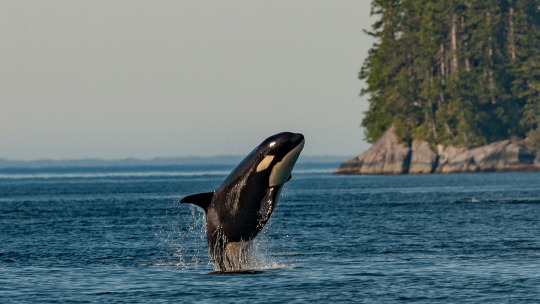
Photo by Thomas Lipke on Unsplash
43 notes
·
View notes
